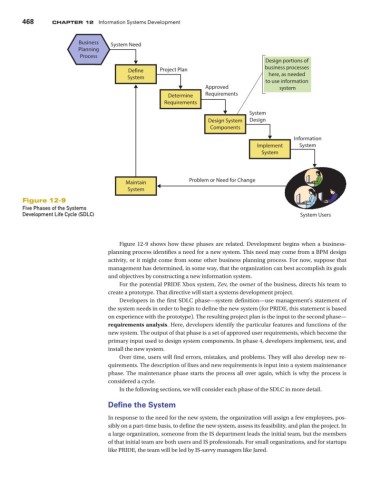Page 500 - Using MIS
P. 500
468 Chapter 12 Information Systems Development
Business System Need
Planning
Process
Design portions of
Dene Project Plan business processes
System here, as needed
to use information
Approved system
Determine Requirements
Requirements
System
Design System Design
Components
Information
Implement System
System
Maintain Problem or Need for Change
System
Figure 12-9
Five Phases of the Systems
Development Life Cycle (SDLC) System Users
Figure 12-9 shows how these phases are related. Development begins when a business-
planning process identifies a need for a new system. This need may come from a BPM design
activity, or it might come from some other business planning process. For now, suppose that
management has determined, in some way, that the organization can best accomplish its goals
and objectives by constructing a new information system.
For the potential PRIDE Xbox system, Zev, the owner of the business, directs his team to
create a prototype. That directive will start a systems development project.
Developers in the first SDLC phase—system definition—use management’s statement of
the system needs in order to begin to define the new system (for PRIDE, this statement is based
on experience with the prototype). The resulting project plan is the input to the second phase—
requirements analysis. Here, developers identify the particular features and functions of the
new system. The output of that phase is a set of approved user requirements, which become the
primary input used to design system components. In phase 4, developers implement, test, and
install the new system.
Over time, users will find errors, mistakes, and problems. They will also develop new re-
quirements. The description of fixes and new requirements is input into a system maintenance
phase. The maintenance phase starts the process all over again, which is why the process is
considered a cycle.
In the following sections, we will consider each phase of the SDLC in more detail.
Define the System
In response to the need for the new system, the organization will assign a few employees, pos-
sibly on a part-time basis, to define the new system, assess its feasibility, and plan the project. In
a large organization, someone from the IS department leads the initial team, but the members
of that initial team are both users and IS professionals. For small organizations, and for startups
like PRIDE, the team will be led by IS-savvy managers like Jared.

